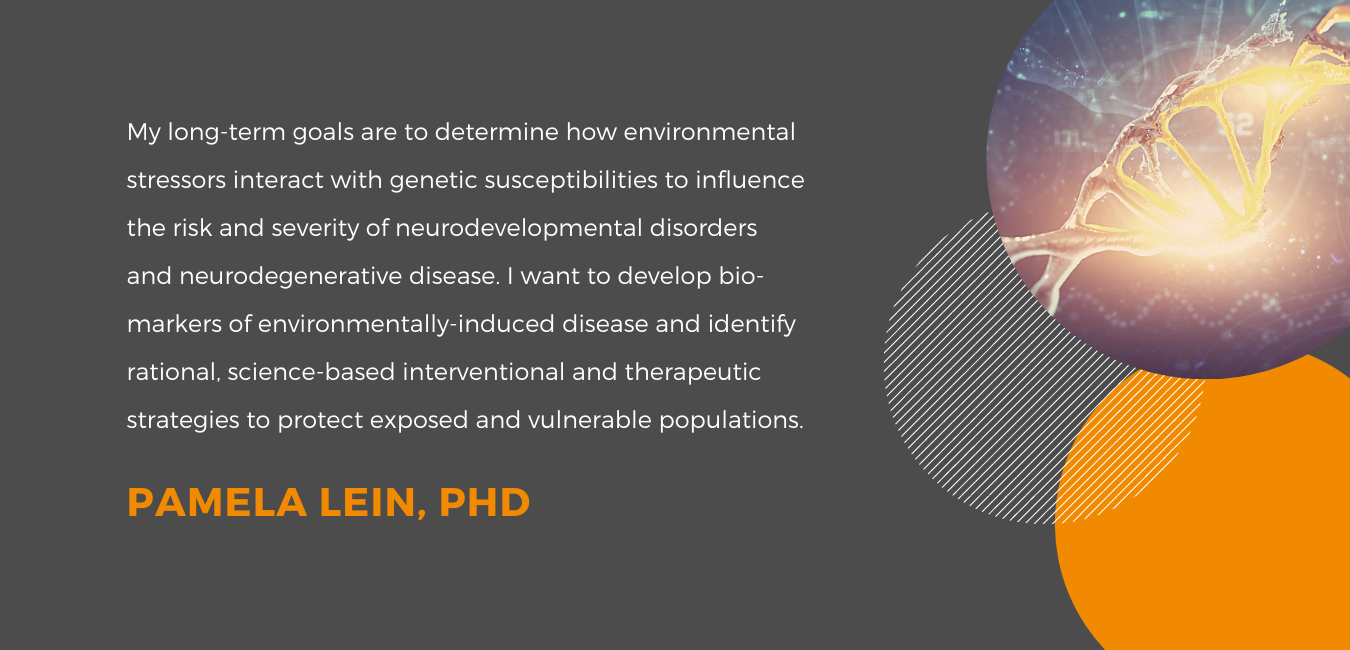

Pamela Lein, PhD is a neurotoxicologist and developmental neurobiologist who studies the interaction between genes and environment that can lead to a variety of complex disorders from asthma to autism and Alzheimer’s.
Dr. Lein’s work focuses on the way environmental stressors like pesticides and near-roadway exposures—which include car exhaust and particles from tire wear and tear—can both change the structure of nerve cells and disrupt how they communicate with each other and with other tissues throughout the body.
Using an array of experimental models and techniques, from primary neuronal cell cultures, zebrafish and rodents, to cellular and molecular testing, in vivo imaging and behavioral studies, Dr. Lein’s groundbreaking research has influenced state and federal policy on the hazards chemicals pose to human health. Through Tox21, her work also contributes to ongoing international efforts identifying the chemicals most likely to negatively affect human health and development.
Dr. Lein’s pioneering research includes:
- Discovering that bone morphogenetic proteins stimulate increased branching in neurons, which controls how many connections they can receive from cells upstream in the neural circuit. Scientists believe that this type of growth may contribute to learning and memory and have found that inappropriate branching (either too much or too little) accompanies behavioral problems, while promoting dendritic growth may help the brain recover from ischemic stroke.
- Providing the first evidence that polychlorinated biphenyls (PCBs), a class of environmental contaminants already shown to interfere with human neurodevelopment, modulate specific signaling pathways and processes in neurodevelopment that are altered in people with neurodevelopmental disorders. This work suggests PCBs may have a causal link with receptors and developmental problems like autism and attention-deficit hyperactivity disorder.
- Proving that the organophosphorus pesticide, chlorpyrifos, interferes with the nervous system that regulates the airways to cause asthma symptoms at levels significantly below those allowed for pest control, a discovery that has influenced changes in state and federal public health policy.
- Demonstrating that persistent organic pollutants have a distinct, toxic effect on neurons by boosting or curbing their growth.
- Identifying PCB 11, which is ubiquitous in pigments sold in the US, as well as in water, air, and the food chain, as potentially harmful to the developing brain. Scientists now screen for PCB 11, to better understand its neurotoxicity.
- Showing that exposure of rodents to real-world traffic-related air pollution (TRAP) alters the way the brain develops, and may speed up the deterioration that Alzheimer’s Disease causes.
Contact
Email: pjlein@ucdavis.edu
Phone: (530) 752-1970
Social media: Twitter
Positions at UC Davis
Chair and Professor, Department of Molecular Biosciences, School of Veterinary Medicine
Director, CounterACT Center of Excellence
Areas of expertise
- Cellular and molecular neurobiology
- Developmental neurobiology
- Neuropharmacology
- Neurotoxicology
- Neuroinflammation
Over the years, Dr. Lein has sat on the editorial boards of a number of peer-reviewed journals and been a member of various scientific programs and committees. Her appointments include:
- Editor-in-Chief, NeuroToxicology
- Editorial Board, Chemical Research in Toxicology
- Editorial Board, Current Research in Toxicology
- Editorial Board, Toxics
- Chair, Society of Toxicology Education and Career Development Committee
- Expert Author, USEPA IRIS Assessment of PCBs
- Scientific Advisor, ENDpoiNTS, EU research consortium, European H2020 EDC Program, Utrecht University, Utrecht, Netherlands
- Member, Committee to Review Report on Long-Term Health Effects on Army Test Subjects National Academies of Sciences, Engineering and Medicine
- Member, NIH CounterACT Program Steering Committee
- Member, Scientific Advisory Panel, U.S. Environmental Protection Agency (USEPA)
- Member, External Advisory Committee, NIEHS Core Center, University of Rochester, NY
- Member, External Advisory Committee, NIEHS T32 Training Program, University of Illinois at Urbana-Champaign
- Member, External Advisory Board, NIA-funded Program Project Grant, “Urban Air Pollution and Alzheimer’s Disease: Risk, Heterogeneity and Mechanisms”, University of Southern California, Los Angeles, CA
- Member, Standing Committee to Advise the Department of State on Unexplained Health Effects on US Government Employees and Their Families at Overseas Embassies, The National Academies of Sciences, Engineering and Medicine
- Member, Committee for the Peer Review of the NTP Monograph on Systemic Review of Fluoride Exposure and Neurodevelopmental and Cognitive Health Effects, The National Academies of Sciences, Engineering, and Medicine
- Member, National Toxicology Program Board of Scientific Counselors
- Endowment Fund Steward, Society of Toxicology Neurotoxicology Specialty Section
Major research papers
Rooney AA et al. 2020. A National Toxicology Program unbiased systematic review of the evidence for long-term effects after acute exposure to sarin nerve agent. Critical Reviews in Toxicology, Aug 5; 50(6):474-490. https://www.tandfonline.com/doi/abs/10.1080/10408444.2020.1787330
Berg EL et al. 2020. Developmental exposure to near roadway pollution produces behavioral phenotypes relevant to neurodevelopmental disorders in juvenile rats. Translational Psychiatry, Aug 17; 10(1), 289. https://pubmed.ncbi.nlm.nih.gov/32807767/
Patten KT et al. 2020. Effects of early life exposure to traffic-related air pollution on brain development in juvenile Sprague-Dawley rats. Translational Psychiatry, May 27; 10(1), 166. https://doi.org/10.1038/s41398-020-0845-3
Anger WK et al. 2020. Magnitude of behavioral deficits varies with job-related chlorpyrifos exposure levels among Egyptian pesticide workers. NeuroToxicology, Mar 2020; 77:216-230. https://pubmed.ncbi.nlm.nih.gov/32006538/
Rude K et al. 2019. Developmental exposure to polychlorinated biphenyls (PCBs) in the maternal diet causes host-microbe defects in weanling offspring mice. Environmental Pollution, Oct 2019; 253:708-721. https://www.ncbi.nlm.nih.gov/pmc/articles/PMC6708608/
Sethi S*, Morgan R* et al. 2019. Comparative analyses of the 12 most abundant PCB congeners detected in human maternal serum for activity at the thyroid hormone receptor and ryanodine receptor. Environmental Science and Technology, Apr 2, 2019; 53(7):3948-3958. *Co-first authors. https://pubmed.ncbi.nlm.nih.gov/31336350/
Dach K et al. 2019. Teratological and behavioral screening of the National Toxicology Program 91-compound library in zebrafish (Danio rerio). Toxicological Sciences, Jan 2019; 167(1):77-91. https://www.ncbi.nlm.nih.gov/pmc/articles/PMC6317431/
Keil KP et al. 2018. PCB 95 promotes dendritic growth in primary rat hippocampal neurons via mTOR-dependent mechanisms. Archives of Toxicology, Aug 2018; 92(10):3163-3173. https://www.ncbi.nlm.nih.gov/pmc/articles/PMC6162988/
Shaffo FC et al. 2018. The organophosphorus pesticide chlorpyrifos induces sex-specific airway hyperreactivity in adult rats. Toxicological Sciences, Jun 25, 2018; 165(1): 244-253. This article was selected as the editor’s highlight for this issue. https://www.ncbi.nlm.nih.gov/pmc/articles/PMC6135637/
Hobson BA et al. (2018) A magnetic resonance imaging study of early brain injury in a rat model of acute DFP intoxication. NeuroToxicology, May 2018; 66:170-178. PMC5940565 This article was selected for the INA-NeuroToxicology best paper award in 2018. https://www.ncbi.nlm.nih.gov/pmc/articles/PMC5940565/
Sethi S et al. 2017. Detection of 3,3′-Dichlorobiphenyl in Human Maternal Plasma and Its Effects on Axonal and Dendritic Growth in Primary Rat Neurons. Toxicological Sciences, Aug 1, 2017; 1;158(2):401-411. https://academic.oup.com/toxsci/article/158/2/401/3828721
Chen H et al. 2017. BDE-47 and BDE-49 inhibit axonal growth in primary rat hippocampal neuron-glia co-cultures via ryanodine receptor-dependent mechanisms. Toxicological Sciences, Apr 2017; 156(2):375-386. An image from this article was featured on the cover of this issue. https://www.ncbi.nlm.nih.gov/pmc/articles/PMC6070026/
Yang D et al. 2014. PCB 136 atropselectively alters morphometric and functional parameters of neuronal connectivity in cultured rat hippocampal neurons via ryanodine receptor-dependent mechanisms. Toxicological Sciences, Jan 2, 2014; 138(2):379-392. This article was selected as the editor’s highlight for this issue. https://www.ncbi.nlm.nih.gov/pmc/articles/PMC4007107/
Lesiak A et al. 2014. The environmental neurotoxicant PCB 95 promotes synaptogenesis via ryanodine receptor-dependent miR132 upregulation. Journal of Neuroscience, Jan 15, 2014; 34(3): 717-25. This article was selected as the editor’s highlight for this issue. https://www.ncbi.nlm.nih.gov/pmc/articles/PMC3891953/
Proskocil BJ et al. 2013. Macrophage TNFα mediates parathion-induced airway hyperreactivity in guinea pigs. American Journal of Physiology Lung Cellular and Molecular Physiology, Apr 15, 2013; 304 (8):L519-29. https://www.ncbi.nlm.nih.gov/pmc/articles/PMC3625991/
Wayman GA et al. 2012. PCB 95 modulates the calcium-dependent signaling pathway responsible for activity-dependent dendritic growth. Environmental Health Perspectives, Jul 2012; 120(7): 1003-1009. https://www.ncbi.nlm.nih.gov/pmc/articles/PMC3404671/
Wayman GA et al. 2012. PCB 95 promotes dendritic growth via ryanodine receptor-dependent mechanisms. Environmental Health Perspectives, Jul 2012; 120(7)-997-1022. https://www.ncbi.nlm.nih.gov/pmc/articles/PMC3404670/
Yang D et al. 2008. Chlorpyrifos and chlorpyrifos-oxon inhibit axon outgrowth by interfering with the morphogenic activity of acetylcholinesterase. Toxicology and Applied Pharmacology, Apr 1, 2008; 228: 32-41. https://www.ncbi.nlm.nih.gov/pmc/articles/PMC2408880/
Proskocil BJ et al. 2008. Antigen sensitization influences organophosphorus pesticide-induced airway hyperreactivity. Environmental Health Perspectives, Mar 2008 116(3): 381-388. https://www.ncbi.nlm.nih.gov/pmc/articles/PMC2265045/
Howard AS et al. 2005. Chlorpyrifos exerts opposing effects on axonal and dendritic growth in primary neuronal cultures. Toxicology and Applied Pharmacology, Sep 1, 2005; 207:112-124. https://pubmed.ncbi.nlm.nih.gov/16102564/
Lein PJ et al. 2005. Organophosphorus insecticides induce airway hyperreactivity by decreasing neuronal M2 muscarinic receptor function independent of acetylcholinesterase inhibition. Toxicological Sciences, Jan 2005; 83:166-176. https://pubmed.ncbi.nlm.nih.gov/15470232/
Howard AS et al. 2003. Polychlorinated biphenyls induce caspase-dependent cell death in cultured embryonic rat hippocampal but not cortical neurons via activation of the ryanodine receptor. Toxicology and Applied Pharmacology, Jul 1, 2003; 190:72-86. https://pubmed.ncbi.nlm.nih.gov/12831785/
Lein PJ et al. 2002. Glia induce dendritic growth in cultured sympathetic neurons by modulating the balance between bone morphogenetic proteins (BMPs) and BMP antagonists. Journal of Neuroscience, Dec 1, 2002; 22:10377-10387. https://pubmed.ncbi.nlm.nih.gov/12451137/
Schuh RA et al. 2002. Noncholinesterase mechanisms of chlorpyrifos neurotoxicity: altered phosphorylation of Ca2+/cAMP response element binding protein in cultured neurons. Toxicology and Applied Pharmacology, Jul 15, 2002; 182:176-185. https://pubmed.ncbi.nlm.nih.gov/12140181/
Lein PJ et al. 1995. Osteogenic protein-1 induces dendritic growth in rat sympathetic neurons. Neuron, Sep 1995; 15:597-605. https://pubmed.ncbi.nlm.nih.gov/7546739/
Honors
- 2020 Graduate Program Advising and Mentoring Award, UC Davis Office of Graduate Studies
- 2018 INA-NeuroToxicology Best Paper Award
- Zoetis Award for Veterinary Research Excellence, UC Davis School of Veterinary Medicine (2015)
- Fellowship, March of Dimes Predoctoral (1987-1990)
Video archive
Environmental Toxins and ASD, Autism Research Institution, January 26, 2017
Education
- Postdoctoral Fellowship in Molecular Immunology, Roswell Park Cancer Institute (1992)
- PhD, Pharmacology and Toxicology, University of Buffalo (1990)
- MS, Environmental Health, East Tennessee State University (1983)
- BS, Biology, Cornell University (1981)
